Alcon Research PUREPT1 PurePoint User Manual NGL Book 1 indb
Alcon Research Ltd. PurePoint NGL Book 1 indb
Contents
- 1. User Manual part 1 of 5
- 2. User Manual part 2 of 5
- 3. User Manual part 3 of 5
- 4. User Manual part 4 of 5
- 5. User Manual part 5 of 5
User Manual part 1 of 5
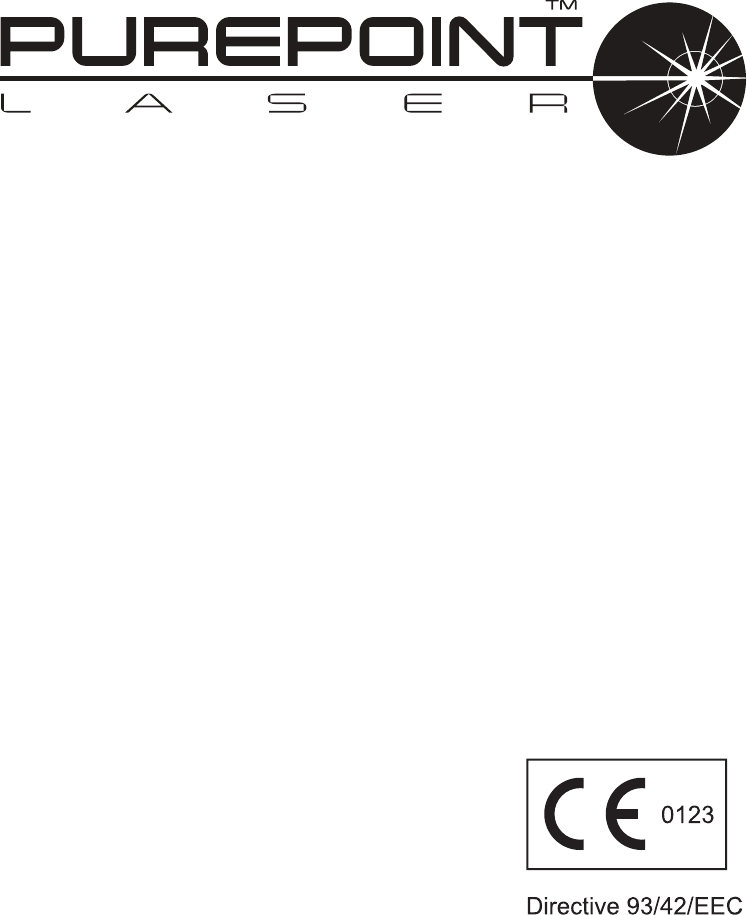
OPERATOR'S MANU
AL
Manufacturer: EU Authorized Representative:
Alcon Laboratories, Inc. Alcon Laboratories (U.K.) Ltd.
6201 South Freeway Boundary Way, Hemel Hempstead
Fort Worth, Texas 76134-2099 Hertfordshire, HP2 7UD England
U.S.A.
Produced By:
Alcon Laboratories, Inc.
15800 Alton Parkway
Irvine, California 92618-3818
U.S.A.
Telephone: 949/753-1393
800/832-7827
FAX: 949/753-6614
8065751131 Rev. P3.5, CATALOG NUMBER
905-5620-001 Rev. P3.5, TEXT ONLY
©
2007 Alcon, Inc
.

ii
8065751131
PurePoint™
Operator's
8065751131
MANUAL REVISION RECORD
DATE REVISION ECN NUMBER AND DESCRIPTION
DATE REVISION ECN NUMBER AND DESCRIPTION
DATE REVISION ECN NUMBER AND DESCRIPTION
CSO is a registered trademark of
Costruzione Strumenti Oftalmici S.R.L.
Nikon is a registered trademark of Nikon Inc. Corporation.
Topcon is a registered trademark of Kabushiki Kaisha Topcon Corporation.
Meditec is a registered trademark of Meditec Reinhardt Thysel GMBH.
Ellex is a registered trademark of Taracan Pty. Ltd.
Zeiss is a registered trademark of Carl-Zeiss-Stifl ung.
Haag-Streit is a registered trademark of Haag-Streit AG Corporation.
Heine is a registered trademark of Hein Optotechnik GmbH.
* Registered U.S. Patent & Trademark Offi ce

8065751131
iii
TABLE OF CONTENTS
TOPIC PAGE #
Manual Revision Record
. . . . . . . . . . . . . . . . . . . . . . . . . . . . . . . . . . . . . . . . . . . . . . . . . . . . . . . . . . . . . . . . . . .
i
i
Foreword
. . . . . . . . . . . . . . . . . . . . . . . . . . . . . . . . . . . . . . . . . . . . . . . . . . . . . . . . . . . . . . . . . . . . . . . . . . . . . . .
v
i
Important Notice
. . . . . . . . . . . . . . . . . . . . . . . . . . . . . . . . . . . . . . . . . . . . . . . . . . . . . . . . . . . . . . . . . . . . . . . . .
v
i
i
SECTION ONE - GENERAL INFORMATION
Introduction
. . . . . . . . . . . . . . . . . . . . . . . . . . . . . . . . . . . . . . . . . . . . . . . . . . . . . . . . . . . . . . . . . . . . . . . . . . . .
1.
1
Technical Specifi cations
. . . . . . . . . . . . . . . . . . . . . . . . . . . . . . . . . . . . . . . . . . . . . . . . . . . . . . . . . . . . . . . . . . .
1.2
Laser Characteristics
. . . . . . . . . . . . . . . . . . . . . . . . . . . . . . . . . . . . . . . . . . . . . . . . . . . . . . . . . . . . . . . . . . . . .
1.2
Environmental Considerations
. . . . . . . . . . . . . . . . . . . . . . . . . . . . . . . . . . . . . . . . . . . . . . . . . . . . . . . . . . . . . .
1.
3
Universal Precautions
. . . . . . . . . . . . . . . . . . . . . . . . . . . . . . . . . . . . . . . . . . . . . . . . . . . . . . . . . . . . . . . . . . . . .
1.4
EMC Statement
. . . . . . . . . . . . . . . . . . . . . . . . . . . . . . . . . . . . . . . . . . . . . . . . . . . . . . . . . . . . . . . . . . . . . . . . .
1.4
FCC and IC Compliance Statement
. . . . . . . . . . . . . . . . . . . . . . . . . . . . . . . . . . . . . . . . . . . . . . . . . . . . . . . . . .
FCC and IC Compliance Statement . . . . . . . . . . . . . . . . . . . . . . . . . . . . . . . . . . . . . . . . . . . . . . . . . . . . . . . . . . FCC and IC Compliance Statement
1.7
Labeling
. . . . . . . . . . . . . . . . . . . . . . . . . . . . . . . . . . . . . . . . . . . . . . . . . . . . . . . . . . . . . . . . . . . . . . . . . . . . . . .
1
.
8
Carring Case
. . . . . . . . . . . . . . . . . . . . . . . . . . . . . . . . . . . . . . . . . . . . . . . . . . . . . . . . . . . . . . . . . . . . . . . . . . . .
1.9
Preparing For Installation
. . . . . . . . . . . . . . . . . . . . . . . . . . . . . . . . . . . . . . . . . . . . . . . . . . . . . . . . . . . . . . . . .
1
.
10
PurePoint™
Laser Safety Features
. . . . . . . . . . . . . . . . . . . . . . . . . . . . . . . . . . . . . . . . . . . . . . . . . . . . . . . . .
1.
1
3
Professional Operator’s Information
. . . . . . . . . . . . . . . . . . . . . . . . . . . . . . . . . . . . . . . . . . . . . . . . . . . . . . . .
1.
1
4
Product Service
. . . . . . . . . . . . . . . . . . . . . . . . . . . . . . . . . . . . . . . . . . . . . . . . . . . . . . . . . . . . . . . . . . . . . . . . .
1.1
7
Limited Warranty
. . . . . . . . . . . . . . . . . . . . . . . . . . . . . . . . . . . . . . . . . . . . . . . . . . . . . . . . . . . . . . . . . . . . . . .
1.1
8
SECTION TWO - DESCRIPTION
Introduction
. . . . . . . . . . . . . . . . . . . . . . . . . . . . . . . . . . . . . . . . . . . . . . . . . . . . . . . . . . . . . . . . . . . . . . . . . . . .
2.
1
Front Panel Description
. . . . . . . . . . . . . . . . . . . . . . . . . . . . . . . . . . . . . . . . . . . . . . . . . . . . . . . . . . . . . . . . . . .
2.
1
Rear Panel Description
. . . . . . . . . . . . . . . . . . . . . . . . . . . . . . . . . . . . . . . . . . . . . . . . . . . . . . . . . . . . . . . . . . . .
2
.
7
Footswitch
. . . . . . . . . . . . . . . . . . . . . . . . . . . . . . . . . . . . . . . . . . . . . . . . . . . . . . . . . . . . . . . . . . . . . . . . . . . . .
2
.
8
System Modes
. . . . . . . . . . . . . . . . . . . . . . . . . . . . . . . . . . . . . . . . . . . . . . . . . . . . . . . . . . . . . . . . . . . . . . . . . .
2.9
Treatment Modes
. . . . . . . . . . . . . . . . . . . . . . . . . . . . . . . . . . . . . . . . . . . . . . . . . . . . . . . . . . . . . . . . . . . . . . . .
2.9
Screen Descriptions
. . . . . . . . . . . . . . . . . . . . . . . . . . . . . . . . . . . . . . . . . . . . . . . . . . . . . . . . . . . . . . . . . . . . .
2
.
10
SECTION THREE - OPERATING INSTRUCTIONS
Introduction
. . . . . . . . . . . . . . . . . . . . . . . . . . . . . . . . . . . . . . . . . . . . . . . . . . . . . . . . . . . . . . . . . . . . . . . . . . . .
3.
1
1 Initial Setup
. . . . . . . . . . . . . . . . . . . . . . . . . . . . . . . . . . . . . . . . . . . . . . . . . . . . . . . . . . . . . . . . . . . . . . . . . .
3.
1
2
System
Connections
. . . . . . . . . . . . . . . . . . . . . . . . . . . . . . . . . . . . . . . . . . . . . . . . . . . . . . . . . . . . . . . . . . . .
3.
1
3
System
Power Up And Set Up
. . . . . . . . . . . . . . . . . . . . . . . . . . . . . . . . . . . . . . . . . . . . . . . . . . . . . . . . . . . .
3.
4
4 Normal Operating Procedure
. . . . . . . . . . . . . . . . . . . . . . . . . . . . . . . . . . . . . . . . . . . . . . . . . . . . . . . . . . . . .
3.
7
5 Turn Off Sequence
. . . . . . . . . . . . . . . . . . . . . . . . . . . . . . . . . . . . . . . . . . . . . . . . . . . . . . . . . . . . . . . . . . . . .
3.
9
6 Changing The System Settings
. . . . . . . . . . . . . . . . . . . . . . . . . . . . . . . . . . . . . . . . . . . . . . . . . . . . . . . . . . .
3.1
0
7 Identifying Unrecognized Probes
. . . . . . . . . . . . . . . . . . . . . . . . . . . . . . . . . . . . . . . . . . . . . . . . . . . . . . . . .
3.11
SECTION FOUR - CARE AND MAINTENANCE
Introduction
. . . . . . . . . . . . . . . . . . . . . . . . . . . . . . . . . . . . . . . . . . . . . . . . . . . . . . . . . . . . . . . . . . . . . . . . . . . .
4.
1
Care And Clean
ing
. . . . . . . . . . . . . . . . . . . . . . . . . . . . . . . . . . . . . . . . . . . . . . . . . . . . . . . . . . . . . . . . . . . . . . .
4.
1
Fuse Replacement Procedure
. . . . . . . . . . . . . . . . . . . . . . . . . . . . . . . . . . . . . . . . . . . . . . . . . . . . . . . . . . . . . . .
4.2
Calibration Verifi cation
. . . . . . . . . . . . . . . . . . . . . . . . . . . . . . . . . . . . . . . . . . . . . . . . . . . . . . . . . . . . . . . . . . .
4.3
System Calibration
. . . . . . . . . . . . . . . . . . . . . . . . . . . . . . . . . . . . . . . . . . . . . . . . . . . . . . . . . . . . . . . . . . . . . . .
4.9
Aiming Beam/LIO Illumination Calibration
. . . . . . . . . . . . . . . . . . . . . . . . . . . . . . . . . . . . . . . . . . . . . . . . . .
4.11
SECTION FIVE - TROUBLESHOOTING
System Messages
. . . . . . . . . . . . . . . . . . . . . . . . . . . . . . . . . . . . . . . . . . . . . . . . . . . . . . . . . . . . . . . . . . . . . . . .
5.
1
SECTION SIX - ACCESSORIES AND PARTS
. . . . . . . . . . . . . . . . . . . . . . . . . . . . . . . . . . . . . . . . . . . . . .
6
.
1
SECTION SEVEN - INDEX
. . . . . . . . . . . . . . . . . . . . . . . . . . . . . . . . . . . . . . . . . . . . . . . . . . . . . . . . . . . . . .
7.
1

iv
8065751131
FIGURE # TITLE PAGE #
LIST OF ILLUSTRATIONS
Figure 1-1 The Alcon
PurePoint
™
Laser
. . . . . . . . . . . . . . . . . . . . . . . . . . . . . . . . . . . . . . . . . . . . . . . . . . .
Laser . . . . . . . . . . . . . . . . . . . . . . . . . . . . . . . . . . . . . . . . . . . . . . . . . . . Laser
1.
1
Figure 1-2 La
b
els and Icons used
on the
PureP
oint
™
Laser
Console
. . . . . . . . . . . . . . . . . . . . . . . . . . . . .
1.
7
Figure 1-3 The
PurePoint™
Carrying Case
. . . . . . . . . . . . . . . . . . . . . . . . . . . . . . . . . . . . . . . . . . . . . . . . .
1.
8
Figure 1-4 Recommended Laser Room Layout
. . . . . . . . . . . . . . . . . . . . . . . . . . . . . . . . . . . . . . . . . . . . .
1.10
Figure 1-5 Re
mote Conne
ctor/Door Lam
p Cir
cuit
Diagram
. . . . . . . . . . . . . . . . . . . . . . . . . . . . . . . . . . .
1.
1
2
Figure 1-
6
Dr. Filter Mes
sage
. . . . . . . . . . . . . . . . . . . . . . . . . . . . . . . . . . . . . . . . . . . . . . . . . . . . . . . . . . .
1.1
5
Figure 2-1 The PurePoint Laser Front Panel
. . . . . . . . . . . . . . . . . . . . . . . . . . . . . . . . . . . . . . . . . . . . . . . .
2.
1
Figure 2-2
Typical
PurePoint™
Screen
. . . . . . . . . . . . . . . . . . . . . . . . . . . . . . . . . . . . . . . . . . . . . . . . . . . .
2.
2
Figure 2-3 Unidentifi able Probe Selection Screen
. . . . . . . . . . . . . . . . . . . . . . . . . . . . . . . . . . . . . . . . . . . .
2.3
Figure 2-4
The
PureP
oint
™
Laser Rear Panel
. . . . . . . . . . . . . . . . . . . . . . . . . . . . . . . . . . . . . . . . . . . . . . .
2
.
2
Figure 2-5
The
PurePoint
™
Laser Footswitch
. . . . . . . . . . . . . . . . . . . . . . . . . . . . . . . . . . . . . . . . . . . . . . .
2.
7
Figure 2-6
Screen
s Displayed on the
PurePoint
™
LCD
. . . . . . . . . . . . . . . . . . . . . . . . . . . . . . . . . . . . . .
2
.
10
Figure 2-
7
Initialization
Scree
n
. . . . . . . . . . . . . . . . . . . . . . . . . . . . . . . . . . . . . . . . . . . . . . . . . . . . . . . . .
2
.
11
Figure 2-
8
Standby
Scree
n
. . . . . . . . . . . . . . . . . . . . . . . . . . . . . . . . . . . . . . . . . . . . . . . . . . . . . . . . . . . . .
2
.
11
Figure 2-
9
Ready
Scree
n
. . . . . . . . . . . . . . . . . . . . . . . . . . . . . . . . . . . . . . . . . . . . . . . . . . . . . . . . . . . . . . .
2
.
12
Figure 2-
10
Laser On
Scree
n
. . . . . . . . . . . . . . . . . . . . . . . . . . . . . . . . . . . . . . . . . . . . . . . . . . . . . . . . . . . .
2.
1
2
Figure 2-
1
1
Main Menu
. . . . . . . . . . . . . . . . . . . . . . . . . . . . . . . . . . . . . . . . . . . . . . . . . . . . . . . . . . . . . . . .
2.
1
2
Figure 2-1
2
Settings
Menu
. . . . . . . . . . . . . . . . . . . . . . . . . . . . . . . . . . . . . . . . . . . . . . . . . . . . . . . . . . . . . .
2.
1
3
Figure 2-1
3
Audio Settings
. . . . . . . . . . . . . . . . . . . . . . . . . . . . . . . . . . . . . . . . . . . . . . . . . . . . . . . . . . . . . .
2.
1
3
Figure 2-14 Contrast Settings
. . . . . . . . . . . . . . . . . . . . . . . . . . . . . . . . . . . . . . . . . . . . . . . . . . . . . . . . . . . .
2.14
Figure 2-15 F
ib
er Custom Pre
-Sets Scr
een
. . . . . . . . . . . . . . . . . . . . . . . . . . . . . . . . . . . . . . . . . . . . . . . . . .
2
.
14
Figure 2-1
6
Footswitch
Settings
. . . . . . . . . . . . . . . . . . . . . . . . . . . . . . . . . . . . . . . . . . . . . . . . . . . . . . . . . .
2.
1
5
Figure 2-1
7
L
anguage
Settings
. . . . . . . . . . . . . . . . . . . . . . . . . . . . . . . . . . . . . . . . . . . . . . . . . . . . . . . . . . .
2.
1
5
Figure 2-1
8
Revert to Standby
Settings
. . . . . . . . . . . . . . . . . . . . . . . . . . . . . . . . . . . . . . . . . . . . . . . . . . . .
2.
1
6
Figure 2-1
9
Tre
atment To
tals
Settings
. . . . . . . . . . . . . . . . . . . . . . . . . . . . . . . . . . . . . . . . . . . . . . . . . . . . .
2.
1
6
Figure 2-
20
Syste
m
Information Menu
. . . . . . . . . . . . . . . . . . . . . . . . . . . . . . . . . . . . . . . . . . . . . . . . . . . .
2.
1
7
Figure 2-
2
1 About
PurePoint™
Screen
. . . . . . . . . . . . . . . . . . . . . . . . . . . . . . . . . . . . . . . . . . . . . . . . . . . .
2.17
Figure 2-22
Version Numbers
. . . . . . . . . . . . . . . . . . . . . . . . . . . . . . . . . . . . . . . . . . . . . . . . . . . . . . . . . . .
2.
1
7
Figure 2-2
3
System Messages
. . . . . . . . . . . . . . . . . . . . . . . . . . . . . . . . . . . . . . . . . . . . . . . . . . . . . . . . . . .
2.
1
8
Figure 2-2
4
System
Totals
. . . . . . . . . . . . . . . . . . . . . . . . . . . . . . . . . . . . . . . . . . . . . . . . . . . . . . . . . . . . . .
2.
1
8
Figure 2-2
5
R
es
et to
Factory Defaults Display
. . . . . . . . . . . . . . . . . . . . . . . . . . . . . . . . . . . . . . . . . . . . . .
2.
1
8
Figure 3-1
S
lit Lamp
Conn
ections
. . . . . . . . . . . . . . . . . . . . . . . . . . . . . . . . . . . . . . . . . . . . . . . . . . . . . . . .
3.
3
Figure 3-2
Display
During Initialization
. . . . . . . . . . . . . . . . . . . . . . . . . . . . . . . . . . . . . . . . . . . . . . . . . . .
3.
4
Figure 3-3
Transition from Stand
by to R
ea
dy
Mode
. . . . . . . . . . . . . . . . . . . . . . . . . . . . . . . . . . . . . . . . . .
3.
8
Figure 3-4
Transition from
R
ea
dy State to L
aser On
. . . . . . . . . . . . . . . . . . . . . . . . . . . . . . . . . . . . . . . . . .
3.
8
Figure 3-5
Transition from
L
aser On to Standby because of a Warning Condition
. . . . . . . . . . . . . . . . . .
3.
9
Figure 3-6
Main Menu
. . . . . . . . . . . . . . . . . . . . . . . . . . . . . . . . . . . . . . . . . . . . . . . . . . . . . . . . . . . . . . . .
3.1
0
Figure 3-7
Settings
Menu
. . . . . . . . . . . . . . . . . . . . . . . . . . . . . . . . . . . . . . . . . . . . . . . . . . . . . . . . . . . . . .
3.1
0
Figure 3-8
Unidentifiable Probe
Display
. . . . . . . . . . . . . . . . . . . . . . . . . . . . . . . . . . . . . . . . . . . . . . . . . .
3.1
1
Figure 4-1 Exposure Time Test Configuration
. . . . . . . . . . . . . . . . . . . . . . . . . . . . . . . . . . . . . . . . . . . . . . .
4.4
Figure 4-2 Power Test Configuration
. . . . . . . . . . . . . . . . . . . . . . . . . . . . . . . . . . . . . . . . . . . . . . . . . . . . . .
4.5
Figure 5-1
Error Message
. . . . . . . . . . . . . . . . . . . . . . . . . . . . . . . . . . . . . . . . . . . . . . . . . . . . . . . . . . . . . . .
5.
2
Figure 6-1
Alcon SL1000 Slit Lamp
. . . . . . . . . . . . . . . . . . . . . . . . . . . . . . . . . . . . . . . . . . . . . . . . . . . . . .
6.2
Figure 6-2
Zeiss 30SL
. . . . . . . . . . . . . . . . . . . . . . . . . . . . . . . . . . . . . . . . . . . . . . . . . . . . . . . . . . . . . . . . . .
Zeiss 30SL . . . . . . . . . . . . . . . . . . . . . . . . . . . . . . . . . . . . . . . . . . . . . . . . . . . . . . . . . . . . . . . . . . Zeiss 30SL
6.2
Figure 6-3
Haag-Streit 900
BM
. . . . . . . . . . . . . . . . . . . . . . . . . . . . . . . . . . . . . . . . . . . . . . . . . . . . . . . . . .
6
.
3
Figure 6-
4
Doctor Protection Filter Mounted Between Binoculars and Slit Lamp Assembly
. . . . . . . . . . .
6
.
4
Figure 6-5
Label Location Diagram on Adaptation - Alcon SL 1000 shown
. . . . . . . . . . . . . . . . . . . . . . . .
6
.
6
Figure 6-
6
To avoid injury, the
beam splitter/accessories must be place
d
between the binoculars
and Doctor Protection Filter (Alcon SL 1000 shown)
. . . . . . . . . . . . . . . . . . . . . . . . . . . . . . . .
6
.
6
Figure 6-
7
Controls on Alcon
SL 1000 Slit Lamp with Doctor Protection Filter and Adaptation Installed
.
6
.
7
Figure 6-
8
Laser Spot Focus
. . . . . . . . . . . . . . . . . . . . . . . . . . . . . . . . . . . . . . . . . . . . . . . . . . . . . . . . . . . . .
6
.
9

8065751131
v
LIST OF TABLES
Table 1-1
Technical
Specifi cations
. . . . . . . . . . . . . . . . . . . . . . . . . . . . . . . . . . . . . . . . . . . . . . . . . . . . . . .
1.
2
Table 1-2
Laser
Characteristics
. . . . . . . . . . . . . . . . . . . . . . . . . . . . . . . . . . . . . . . . . . . . . . . . . . . . . . . . . .
1.
2
Table 1-3 Guidance and Manufacturer's Declaration -
Electromagnetic Emissions
. . . . . . . . . . . . . . . . .
1.
4
Table 1-4 Guidance and Manufacturer's Declaration -
Electromagnetic Immunity
. . . . . . . . . . . . . . . . . .
1.
5
Table 1-5 Recommended
Separation
Distances Between Portable and Mobile RF
Communications Equipment and the
Pur
ePoint
PurePointPur
™
Laser
. . . . . . . . . . . . . . . . . . . . . . . . . . . . .
1.
6
Table 2-1 532 Green Laser Power Values (in milliwatts)
. . . . . . . . . . . . . . . . . . . . . . . . . . . . . . . . . . . . . .
2.
2
Table 4-1 Energy Matrix
. . . . . . . . . . . . . . . . . . . . . . . . . . . . . . . . . . . . . . . . . . . . . . . . . . . . . . . . . . . . . . .
4.7
Table 6-1
PurePoint™
Laser
Accessories
. . . . . . . . . . . . . . . . . . . . . . . . . . . . . . . . . . . . . . . . . . . . . . . . . .
6
.
1
Table 6-2
Adaptation Troubleshooting
. . . . . . . . . . . . . . . . . . . . . . . . . . . . . . . . . . . . . . . . . . . . . . . . . . . .
6
.
9
Table 6-3
Alcon
LIO-AT Technical Specifi cations
. . . . . . . . . . . . . . . . . . . . . . . . . . . . . . . . . . . . . . . . . .
6.12
TABLE # TITLE PAGE #
Figure 6
-
9 Alcon LIO-AT
. . . . . . . . . . . . . . . . . . . . . . . . . . . . . . . . . . . . . . . . . . . . . . . . . . . . . . . . . . . . . .
6.10
Figure 6-10 Alcon LIO-AT Labeling
. . . . . . . . . . . . . . . . . . . . . . . . . . . . . . . . . . . . . . . . . . . . . . . . . . . . . .
6.12
Figure 6-11 Adjusting the LIO-AT Overband
. . . . . . . . . . . . . . . . . . . . . . . . . . . . . . . . . . . . . . . . . . . . . . .
6.14
Figure 6-12 LIO-AT Controls and Adjustments
. . . . . . . . . . . . . . . . . . . . . . . . . . . . . . . . . . . . . . . . . . . . . .
6.15
Figure 6-13 Eyecup Retainers and Ocular Lens on the Alcon LIO-AT
. . . . . . . . . . . . . . . . . . . . . . . . . . . .
6.16
Figure 6-14 Alcon
LIO-AT Bulb Replacement
. . . . . . . . . . . . . . . . . . . . . . . . . . . . . . . . . . . . . . . . . . . . . .
6.20
FIGURE # TITLE PAGE #
LIST OF ILLUSTRATIONS

vi
8065751131
FOREWORD
This Operator's Manual is designed to acquaint the operator and operating room personnel
with the
Next Generation
Laser. The manual presents an organized summary of the operating
principles, main components, safety features, and instructions for care and use of the
instrument.
The information in this manual should be supplemented with reference works on laser theory
and the interaction of laser energy with biologic tissues. No attempt is made in this manual
to answer all the questions that arise during the use of the instrument in medical procedures.
Questions concerning technique, safety and effectiveness should be referred to pertinent
publications or recognized medical experts in laser surgery. Physicians should not attempt to
treat patients with this instrument if not thoroughly familiar with its operation, or if in doubt
as to its safe operation. All personnel authorized to use this instrument should be required to
be thoroughly familiar with this manual.
Please contact Alcon for complete technical support and service if you have questions
concerning any aspect of this instrument's operation or if it fails to perform satisfactorily.
To order
supplies in U.S.A.:
800-862-5266
FAX: 800-241-0677
Outside U.S.A.: Contact your local Alcon representative for supplies.
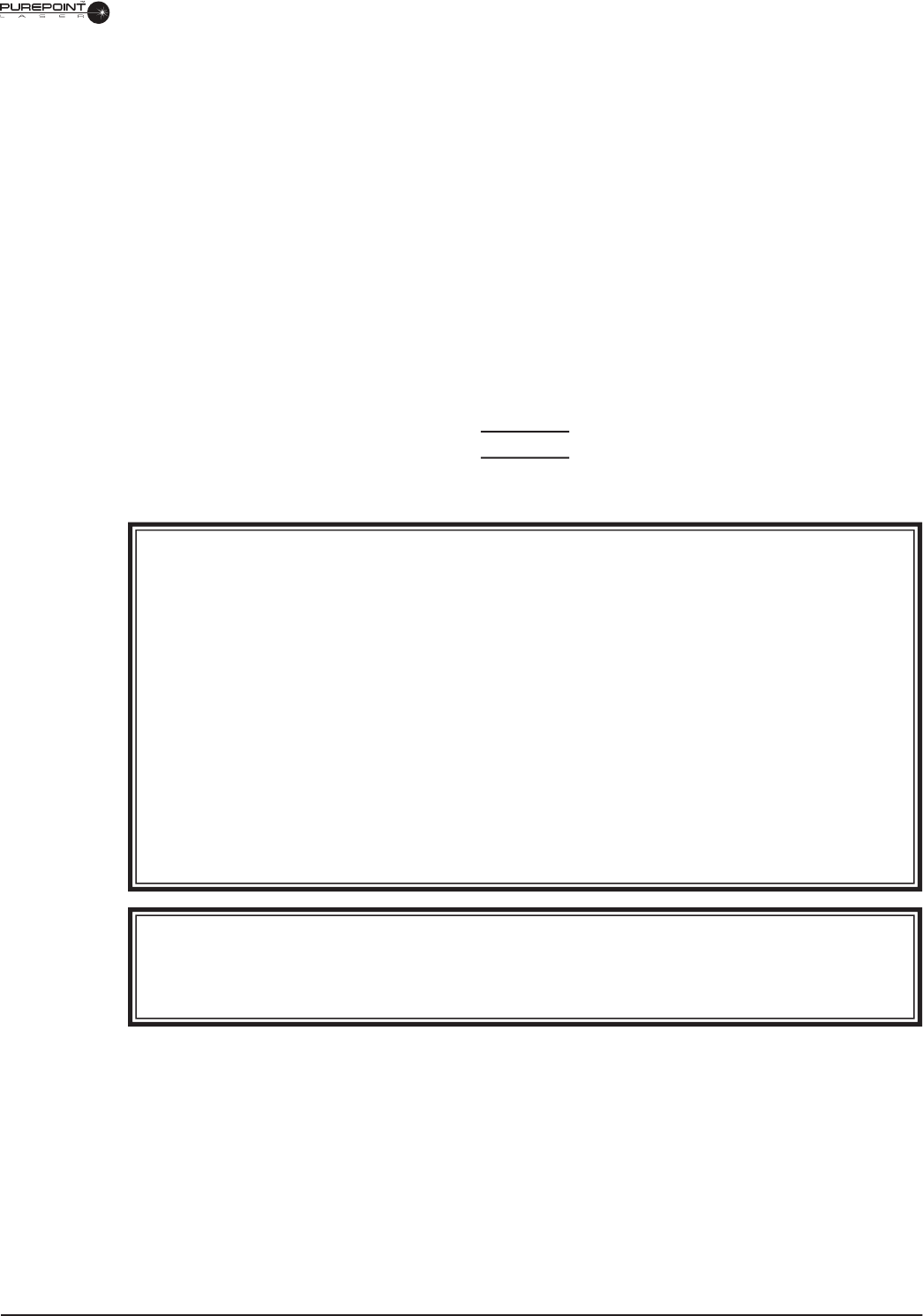
8065751131
vii
IMPORTANT NOTICE
Equipment improvement is an on-going process and, as such, changes may be made to the
equipment after this manual is printed.
Pay close attention to
WARNINGS
and
CAUTIONS
in this manual.
WARNINGS
are written
to protect individuals from bodily harm.
CAUTIONS
are written to protect the instrument
from damage. Illustrations contained in this manual are for reference only.
It is recommended that maintenance be performed by a qualifi ed Alcon Field Engineer.
Alcon Surgical shall not be liable for any damage resulting from failure to comply with the
enclosed instructions.
Alcon reserves the right to change specifi cations without further notice.
CAUTION
U.S. Federal Law restricts this device to sale by or on the order of a physician only.
WARNINGS!
Use of controls or adjustments, or performance of procedures other than those specifi ed
herein may result in hazardous laser radiation exposure.
A qualifi ed technician must perform a visual inspection of the following components
every twelve months. In case of a defi ciency, do not use the system; call Alcon Technical
Services.
- Warning Labels
- Power Cord
- Fuses
A qualifi ed technician must check ground continuity and both polarities for leakage
current every twelve months to ensure they are within the applicable standard (for
example: EN 60601-1/IEC 601-1). Values must be recorded, and if they are above the
applicable standard, or 50% above your fi rst measurement, do not use the system; call
Alcon Technical Services.
WARNING!
Use of accessories and cables other than those provided may result in increased
emissions or decreased immunity of the system. Portable and mobile RF
communications equipment can affect this medical electrical equipment.
Comments or corrections concerning this manual should be addressed to:
Alcon
Technical Services Group
PO BOX 19587
Irvine, CA, USA 92623
All rights reserved. No part of this manual may be reproduced, transmitted, or stored in
a retrieval system, in any form or by any means; photocopying, electronic, mechanical,
recording, or otherwise; without prior written permission from Alcon Laboratories, Inc.

viii
8065751131
THIS PAGE INTENTIONALLY BLANK
LAST PAGE OF THIS SECTION
8065751131
LAST PAGE OF THIS SECTION
8065751131
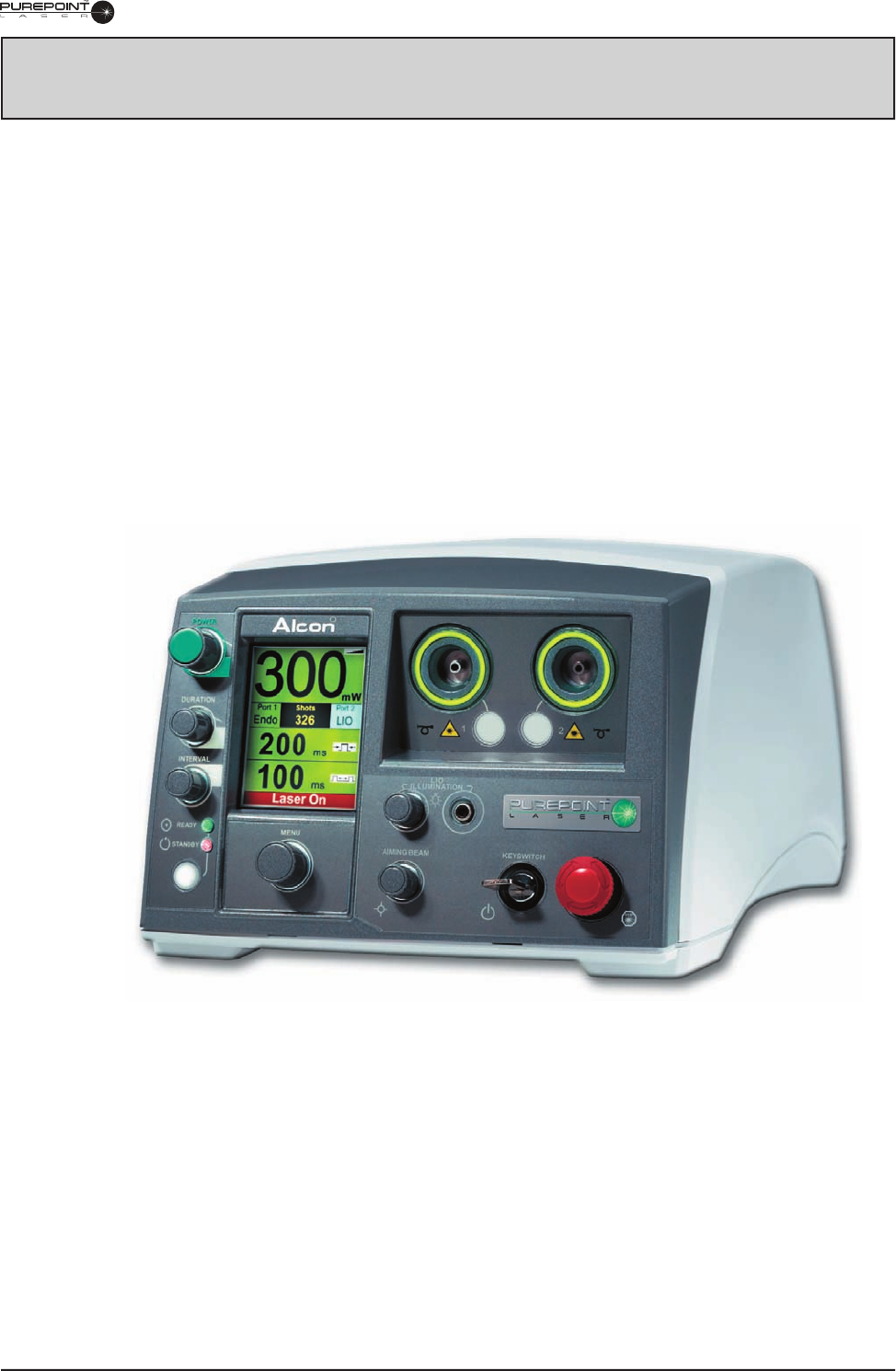
8065751131 1.1
SECTION ONE
GENERAL INFORMATION
INTRODUCTION
The Alcon
PurePoint™
Laser provides an exceptional combination of performance,
solid-state reliability, versatility, and portability all in one system. It is a diode-
pumped solid-state type laser designed for ophthalmic use. This laser delivers a
visible 532 nm green treatment beam, and a visible 635 nm Diode Laser aiming beam
(635 nm is an approximate value between 630-640 nm).
The system is also supported by a wide range of high quality laser probes, a laser
indirect ophthalmoscope (LIO), and is compatible with a wide variety of slit lamps.
Figure 1-1 The Alcon
PurePoint™
Laser

1.2
8065751131
Table 1-1
Technical
Specifi cations
CATEGORY
SPECIFICATION
Approximate Dimensions
Width: 0.23 m (9.00 inches)
Depth: 0.34 m (13.50 inches)
Height: 0.18 m (7.00 inches)
Approximate Weight
10.4 kg (23 lbs)
Electrical Characteristics
Voltage: 100-120 VAC@ 5 A (max current)
220-240 VAC @ 2.5 A (max current)
Frequency: 50/60 Hz
Fuse rating: 250V,Single Phase T5 Amps
Insulation class: Class I, type BF,
Fuse rating: 250V,Single Phase T5 Amps
Environmental Limitations
Operating: Temperature: 10°C ≤ T°≤ 35°C
Relative Humity: 10% to 90% with no condensation
Storage: Temperature: -40°C ≤ T°≤ 70°C
Relative Humity: 10% to 95% with no condensation
Miscellaneous
PurePoint
Laser complies with CE MDD requirements.
PurePoint
Laser complies with CE MDD requirements.
PurePoint
Not suitable for use in the presence of fl ammable anesthetic, oxygen or
nitrous oxide.
System not protected against the ingress of water.
Leakage current per IEC 60601-1 is below 500 micro amps at 264 VAC.
Leakage current per IEC 60601-1 is below 300 micro amps at 132 VAC.
Ground continuity per IEC 60601-1 is below 0.1 ohm.
Table 1-2
Laser
Characteristics
CATEGORY
TREATMENT LASER BEAM
AIMING LASER BEAM
Laser Class
IV
II
Laser Power
• 30 mW to 200 mW in 10 mW
steps
• 200 mW to 500 mW in 20 mW
steps with additional steps at:
250, 350, 450
• 500 mW to 950 mW in 50 mW
steps
• 1000 mW to 2000 mW in 100
mW steps
Less than 1 mW; adjustable by
operator
Laser Wavelength
532 nm
635 nm +/- 5 nm
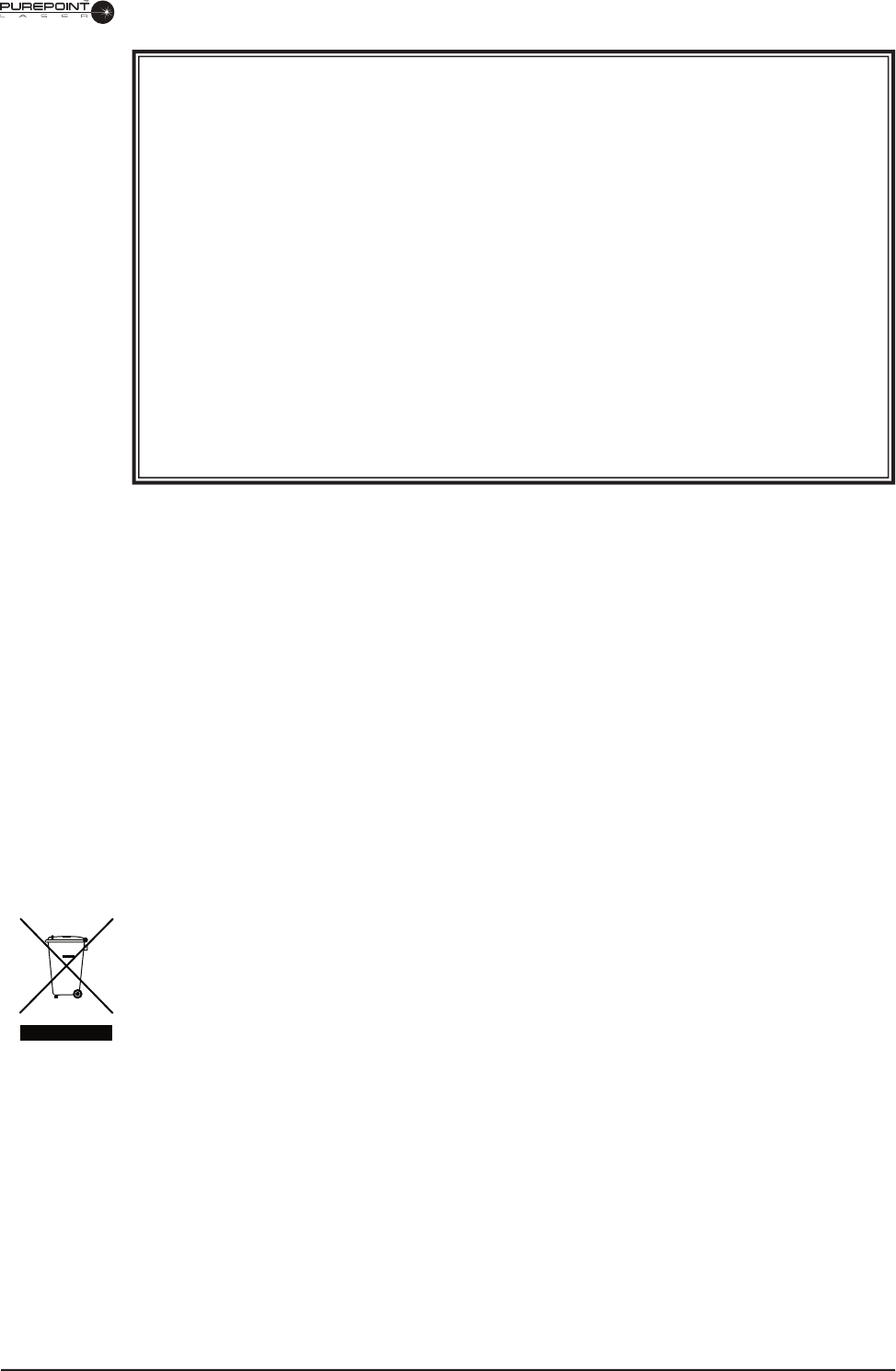
8065751131 1.3
WARNINGS!
There are potential hazards when inserting, steeply bending, or improperly securing
the fiber optic. Not following the recommendations of the manufacturer may lead
to damage to the fiber or delivery system and/or harm to the patient or user.
Since the aiming beam passes down the same delivery system as the treatment
beam, it provides a good method of checking the integrity of the delivery system.
If the aiming beam spot is not present at the distal end of the delivery system,
or its intensity is reduced or it looks diffused, this a possible indication of a
damaged or not properly working delivery system. If there is any doubt, contact
Alcon Technical Services.
The use of flammable anesthetics or oxidizing gases such as nitrous oxide (N
2
O)
and oxygen should be avoided. Some materials - for example cotton wool when
saturated with oxygen - may be ignited by the high temperatures produced in normal
use of the laser equipment. The solvents of adhesives and flammable solutions
used for cleaning and disinfecting should be allowed to evaporate before the laser
equipment is used. There is also danger of ignition of endogenous gases.
NOTE: To eliminate power consumed when the key switch is off, turn off the
main power switch on the rear panel.
Environmental Considerations
The equipment that you have purchased requires the use of natural resources for its
production. This equipment may also contain hazardous substances which could have
potential effect on the environment and human health if disposed of improperly.
In order to avoid the entry of any such substances into our environment and to
promote natural resource conservation, we encourage you to use the appropriate take-
back systems. Such take-back systems reuse or recycle many of the materials in your
end-of-life equipment in a benefi cial way. Please contact your local Alcon offi ce for
assistance in take-back options through Alcon or other providers.
The crossed-bin symbol located on this equipment reminds you to use take-back
systems, while also emphasizing the requirement to collect waste equipment
separately, and not dispose of it as unsorted municipal waste.
If you need more information on the collection, reuse, or recycle systems available to
you, please contact your local or regional waste administration, or contact your local
Alcon offi ce for more information.

1.4
8065751131
Universal Precautions
Universal precautions shall be observed by all people who come in contact with the
instrument and/or accessories to help prevent their exposure to blood-borne pathogens
and/or other potentially infectious materials. In any circumstance, wherein the exact
status of blood or body fl uids/tissues encountered are unknown, it shall be uniformly
considered potentially infectious and handled in accordance with OSHA guidelines.
EMC Statement
It is important to install and use the equipment in accordance with the instructions
in order to prevent harmful interference with other devices in the vicinity. If this
equipment causes harmful interference to other devices (determined by turning the
equipment off and on), the user is encouraged to try to correct the interference by one
or more of the following measures:
Reorient or relocate the other device(s).
• Increase the distance between the equipment.
• Connect this equipment into an outlet on a circuit different from that to which the
other device(s) is connected.
• Consult the manufacturer or your Alcon field service engineer for help.
•
Table 1-3 Guidance and Manufacturer's Declaration -
Electromagnetic Emissions - The
PurePoint™
Laser is intended for use in the electromagnetic environment speci-
fi ed below. The customer or the user of the
PurePoint™
Laser should assure
that it is used in such an environment.
Emissions Test Compliance Electromagnetic Environment-Guidance
RF emissions
CISPR 11
Group 1 The PurePoint™ Laser uses RF energy only for its internal function. Therefore, its
RF emissions are very low and are not likely to cause any interference in nearby
electronic equipment.
RF emissions
CISPR 11
Class A Based on extensive fi eld experience the PurePoint™ Laser is suitable for use in
all establishments other than domestic and those directly connected to the public
low voltage power supply network that supplies buildings used for domestic
purposes.
The EMC Statement provides guidance on steps to take in case of electromagnetic
interference.
Harmonic emissions
IEC 61000-3-2
Class A
Voltage fl uctuations/
Flicker emissions
IEC 61000-3-3
Complies

8065751131 1.5
Table 1-4 Guidance and Manufacturer's Declaration -
Electromagnetic Immunity - The
PurePoint™
Laser is intended for use in the electromagnetic environment
specifi ed below. The customer or the user of the
Next Generation
Laser should
assure that it is used in such an environment.
Immunity Test IEC 60601 Test Level Compliance Level Electromagnetic Environment-Guidance
Electrostatic
discharge (ESD)
IEC 61000-4-2
• ±6 kV contact
• ±8 kV air
• ±6 kV contact
• ±8 kV air
Floors should be wood, concrete, or ceramic tile.
Do
not use around fl oors that are covered with
synthetic material to avoid laser stoppage due to
ESD.
Electrical fast
transient/burst
IEC 61000-4-4
• ±2 kV for power
supply lines
• ±1 kV for input/output
lines
• ±2 kV for power
supply lines
• ±1 kV for input/
output lines
Mains power quality should be that of a typical
commercial or hospital environment. To avoid laser
stoppage due to fast transients avoid powering the
PurePoint™ Laser on the same branch circuit with
sources that can generate fast transients (inductive
switching; e.g., high current motors).
Surge
IEC 61000-4-5
• ±1 kV differential
mode
• ±2 kV common mode
• ±1 kV differential
mode
• ±2 kV common
mode
Mains power quality should be that of a typical
commercial or hospital environment. To avoid
laser stoppage due to power-line surges consider
powering the PurePoint™ Laser through branch
circuit that has surge suppressor for protection
against lightning surges (e.g., at power panel to
surgical/offi ce suite).
Voltage dips, short
interruptions, and
voltage variations
on power supply
input lines
IEC 61000-4-11
• <5% UT (>95% dip in
UT) for 0.5 cycle
• 40% UT (60% dip in
UT) for 5 cycles
• 70% (30% dip in UT)
for 25 cycles
• <5% (>95% dip in
UT) for 5 sec
• <5% UT (>95% dip
in UT) for 0.5 cycle
• 40% UT (60% dip
in UT) for 5 cycles
• 70% (30% dip in
UT) for 25 cycles
• <5% (>95% dip in
UT) for 5 sec
Mains power quality should be that of a typical
commercial or hospital environment. If the uses of
the PurePoint™ Laser require continued operation
during power mains interruptions, it is recommended
that the PurePoint™ Laser be powered from an
uninterruptible power supply or a battery.
Power frequency
(50/60 Hz)
magnetic fi eld
IEC 61000-4-8
3 A/m 3 A/m Power frequency magnetic fi elds should be at
levels characteristic of a typical location in a typical
commercial or hospital environment.
Conducted RF
IEC 61000-4-6
Radiated RF
IEC 61000-4-3
3 Vrms
150 kHz to 80 MHz
3 V/m
80 MHz to 2.5 GHz
3 Vrms
3V/m
Portable and mobile RF communications equipment
should be used no closer to any part of the
PurePoint™ Laser, including cables, than the
recommended separation distance calculated
from the equation applicable to the frequency to
the transmitter.
Recommended separation distance:
d = 1.2√P
d = 1.2√P 80 MHz to 800 MHz
d = 2.3√P 800 MHz to 2.5 GHz
where P is the maximum output power rating to the
transmitter in watts (W) according to the transmitter
manufacturer and d is the recommended separation
distance in meters (m).
Field strength from fixed RF transmitters, as
determined by an electromagnetic site surveya,
should be less than the compliance level in each
frequency rangeb.
Interference may occur in the vicinity of
equipment marked with following symbol.
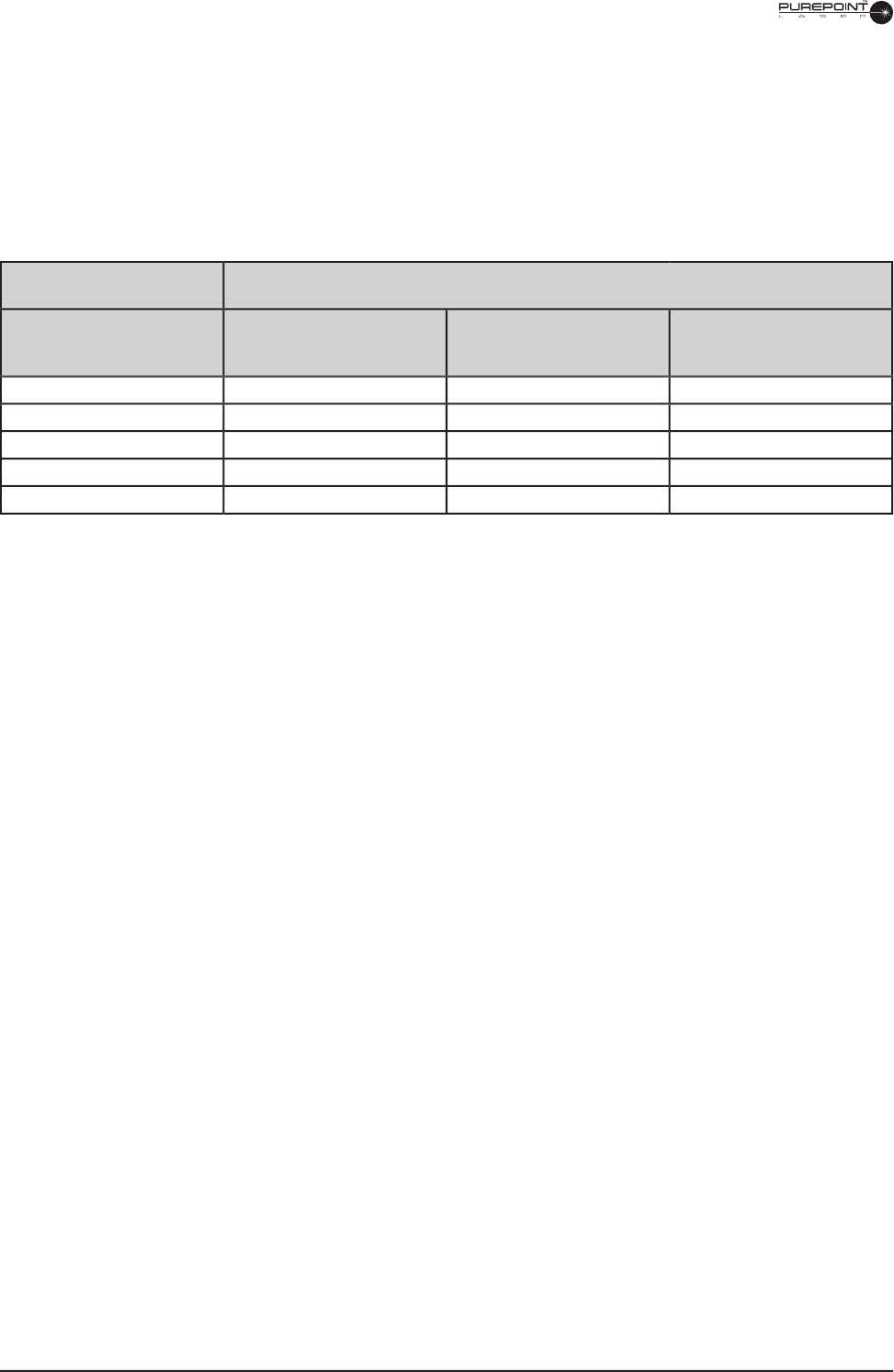
1.6
8065751131
Separation distance according to frequency of transmitter
(m)
Rated maximum output
power of transmitter
(W)
150 kHz to 80 MHz
d = 1.2√P
80 MHz to 800 MHz
d = 1.2√P
800 MHz to 2.5 GHz
d = 2.3√P
0.01
0.12
0.12
0.23
0.1
0.38
0.38
0.73
1
1.2
1.2
2.3
10
3.8
3.8
7.3
100
12
12
23
Table 1-5 Recommended
Separation
Distances Between Portable and Mobile RF Communi-
cations Equipment and the
PurePoint™
Laser - The
PurePoint™
Laser is intended
for use in an electromagnetic environment in which radiated RF disturbances are
controlled. The customer or the user of the
PurePoint™
Laser can help prevent
electromagnetic interference by maintaining a minimum distance between porta-
ble and mobile RF communications equipment (transmitters) and the
PurePoint™
Laser as recommended below, according to the maximum output power of the
communications equipment.
For transmitters rates at a maximum output power not listed above, the recommended separation distance d in meters (m) can
be estimated using the equation applicable to the frequency of the transmitter, where P is the maximum output power rating of the
transmitter in watts (W) according to the transmitter manufacturer.
Note 1 - At 80 MHz and 800 MHz, the separation distance for the higher frequency range applies.
Note 2 - These guidelines may not apply in all situations. Electromagnetic propagation is affected by absorption and refl ection from
structures, objects, and people.

8065751131 1.7
FCC and IC Compliance Statement
Equipment contains Radio Frequency Identifi cation (RFID) device.
Operating Frequency: 13.56 MHz
Type of modulation: Amplitude Shift Keying (ASK)
Output power (e.i.r.p): 703 nW
This device complies with Part 15 of the FCC Rules and with Industry Canada Radio
Standards Specifi cation RS-210.
Operation is subject to the following two conditions:
(1) This device may not cause harmful interference, and (2) this device must accept
any interference received, including interference that may cause undesired operation.
CAUTIONS
Change or modifi cations made to this equipment not expressly approved by Alcon
may void the FCC authorization to operate this equipment.
To ensure that the RFID transmitter complies with current FCC regulations limiting
both maximum output RF power and human exposure to radio frequency radiation, a
separate distance of at least 20 cm must be maintained between the unit’s antenna and
the body of the user and any nearby persons at all times and in all applications and
uses.
This device complies with the RF exposure limits for humans as called out in
RSS-102.
Europe - R&TTE Directive 99/5/EC
This device complies with the requirements of the Council Directive 99/5/EC
(R&TTE).
Australia and New Zealand
This device complies with the Australian/New Zealand Standard AS/NZS 4268:
2003 Radio Equipment and Systems – Short Range Devices – Limits and methods
measurement.
Canada
This ISM device complies with Canadian ICES-001.
(Cet appareil ISM est conforme a la norme NMB-001 du Canada.)
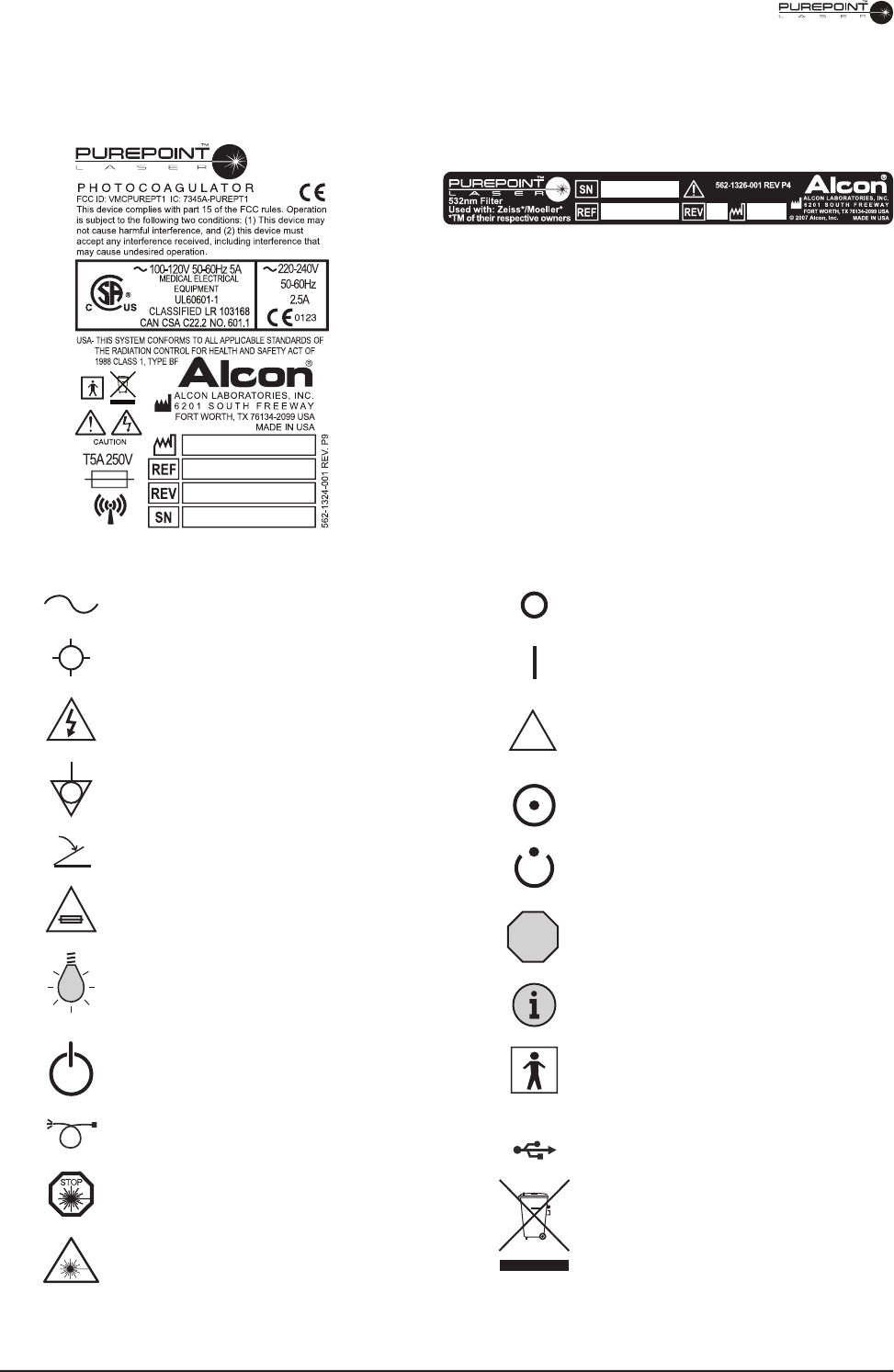
1.8
8065751131
LABELING
Figure 1-2 shows the labeling found on the
PurePoint™
Laser.
Figure 1-2 Labels and Icons on
PurePoint™
Laser Console
Alternating Current
Aiming Beam
Dangerous Voltage
Equipotentiality
Footswitch
Fuse
Illumination
Keyswitch
Laser Connection
Laser Emergency Stop Switch
1
Laser Port
Off
On
!
Consult Operator's Manual, or
System Error or Advisory
Ready
Standby State
SYSTEM
FAULT
System Fault
System Information
Type BF Equipment
USB Connector
Use appropriate take-back system
(see Environmental Considerations
in this manual).
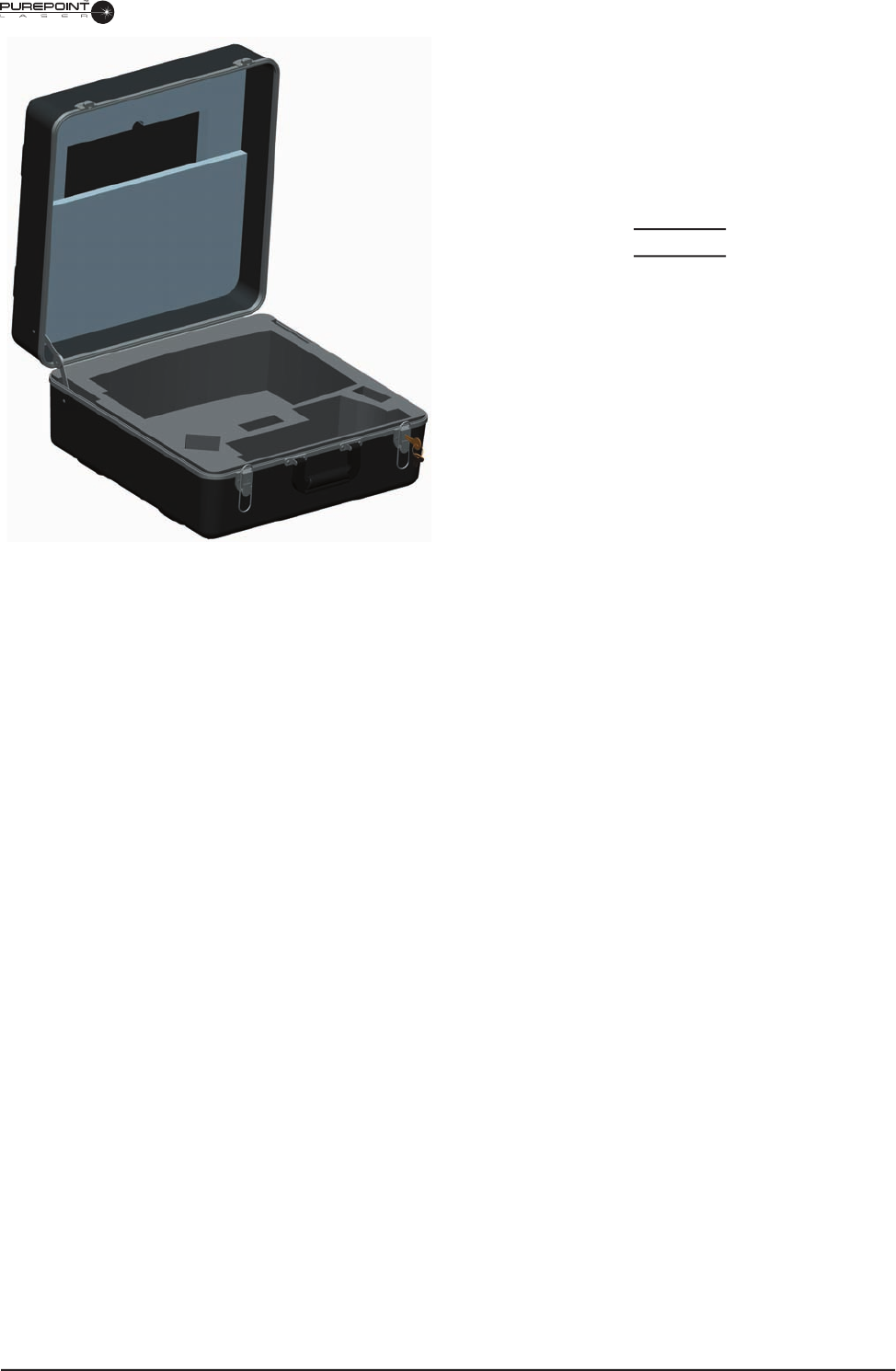
8065751131 1.9
Figure 1-4 The
PurePoint™
Carrying Case
Carrying Case
The carrying case shown in Figure 1-4 is
included with the system and intended to be
used as an aid to carrying the system.
CAUTION
The carrying case should not be used for
shipping the system.
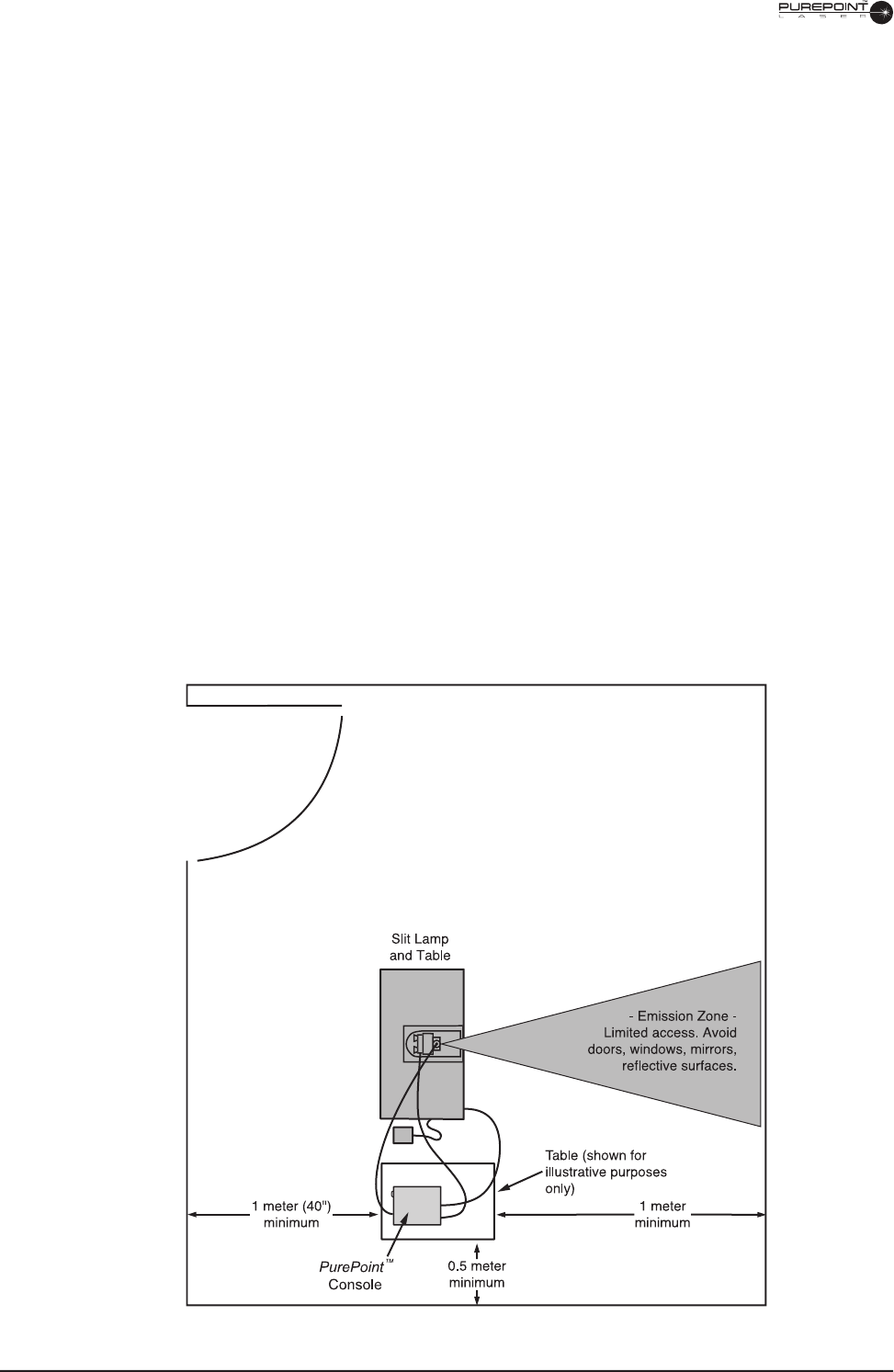
1.10
8065751131
PREPARING FOR INSTALLATION
The
PurePoint™
Laser system was thoroughly inspected and carefully packaged
for shipping. If the container is damaged, leave system in original container with
packaging and request inspection by the carrier within 3 days of delivery.
Included as part of the packaging is the carry box for the
PurePoint™
Laser. This
container is intended to protect the system when moving it from one location to
another. Use the carry box whenever the system must be moved.
Initial installation must be performed by an Alcon representative. Prepare the facility
for installation of the
PurePoint™
Laser as follows:
General Laser Room Layout
The
PurePoint™
Laser must be installed in a dust free room, and positioned so the
laser beam cannot be directed toward a door, window, mirror, or refl ective area. To
reduce dust, avoid installing the instrument in a carpeted room. An example of a
typical laser room layout is shown in Figure 1-4.
Approximate Dimensions of the
PurePoint™
Laser console:
• Width (overall) = 0.23 m (9 inches)
• Length (overall) = 0.35 m (13.5 inches)
• Maximum height (overall) = 0.18 m (7 inches)
• Weight = <13.6 Kilos (30 lbs.)
Figure 1-4 Recommended Laser Room Layout (Overhead View)

8065751131 1.11
NOTE: The accessory equipment connected to or used with this equipment must
be certifi ed according to the respective IEC standard; e.g., IEC 950 for
data processing equipment (data processing equipment must not be
used during patient treatment) and IEC 601-1 for medical equipment.
Additionally, all confi gurations shall comply with the system standard
IEC 601-1-1. Anyone connecting additional equipment or otherwise
causing a different system confi guration than provided by Alcon, is
responsible for continued compliance to the requirements of the System
Standard IEC 601-1-1. If in doubt, consult the Technical Services
department of your local Alcon representative.
It is recommended not to use a power strip to plug in accessory
equipment. Each accessory should be plugged into a wall unit.
General Safety Precautions (Refer to IEC 825-1 or ANSI Z136.1)
• A laser safety officer should be appointed to supervise the installation and use of
the system.
• Install an indicator light outside the laser room warning of instrument operation.
• Position the instrument so that the laser beam is never directed toward a door,
window or reflective surface.
• Use non-reflective matte finish wall paint.
• Avoid covering laser room floor and walls with carpet or any other dust
generating material. This will minimize the possibility of excess grime and dust
on the instrument optics, and interference with equipment cooling.
• The instrument requires a minimum of 0.5 meter of open space on all sides for
proper cooling ventilation. Therefore, the system should be set flat, resting on the
legs provided on the bottom of the console.
• Unauthorized use of this laser should be prevented by removing the On/Off key.
• Entrances to areas or protective enclosures containing Class IV lasers should be
posted with appropriate warning signs.
• Appropriate eye protection must be used in all hazard areas. Use eye protection
with OD 4 or above at 532 nm.
Nominal Ocular Hazard Distance (NOHD)
Accessory Beam Divergence (NOHD)
Accessory Beam Divergence (NOHD)
LIO 0.024 radians (20 meters)
Slit Lamp 0.011 radians (40 meters)
Endoprobe 0.23 radians (3 meters)
Accessory Beam Divergence (NOHD)
Accessory Beam Divergence (NOHD)
Accessory Beam Divergence (NOHD)
Accessory Beam Divergence (NOHD)
LIO 0.024 radians (20 meters)
Slit Lamp 0.011 radians (40 meters)
Endoprobe 0.23 radians (3 meters)
Accessory Beam Divergence (NOHD)
LIO 0.024 radians (20 meters)
Slit Lamp 0.011 radians (40 meters)
Endoprobe 0.23 radians (3 meters)
• A qualified technician must verify that the power plug used is properly grounded.
• The remote interlock connector should be connected to an emergency master
disconnect interlock or to room/door/fixture interlocks. Please refer to figure 1-5.
• The footswitch, the endoprobe, LIO, and the slit lamp adaptation/slit lamp should
be placed within 2 meters of the
PurePoint™
Laser console.
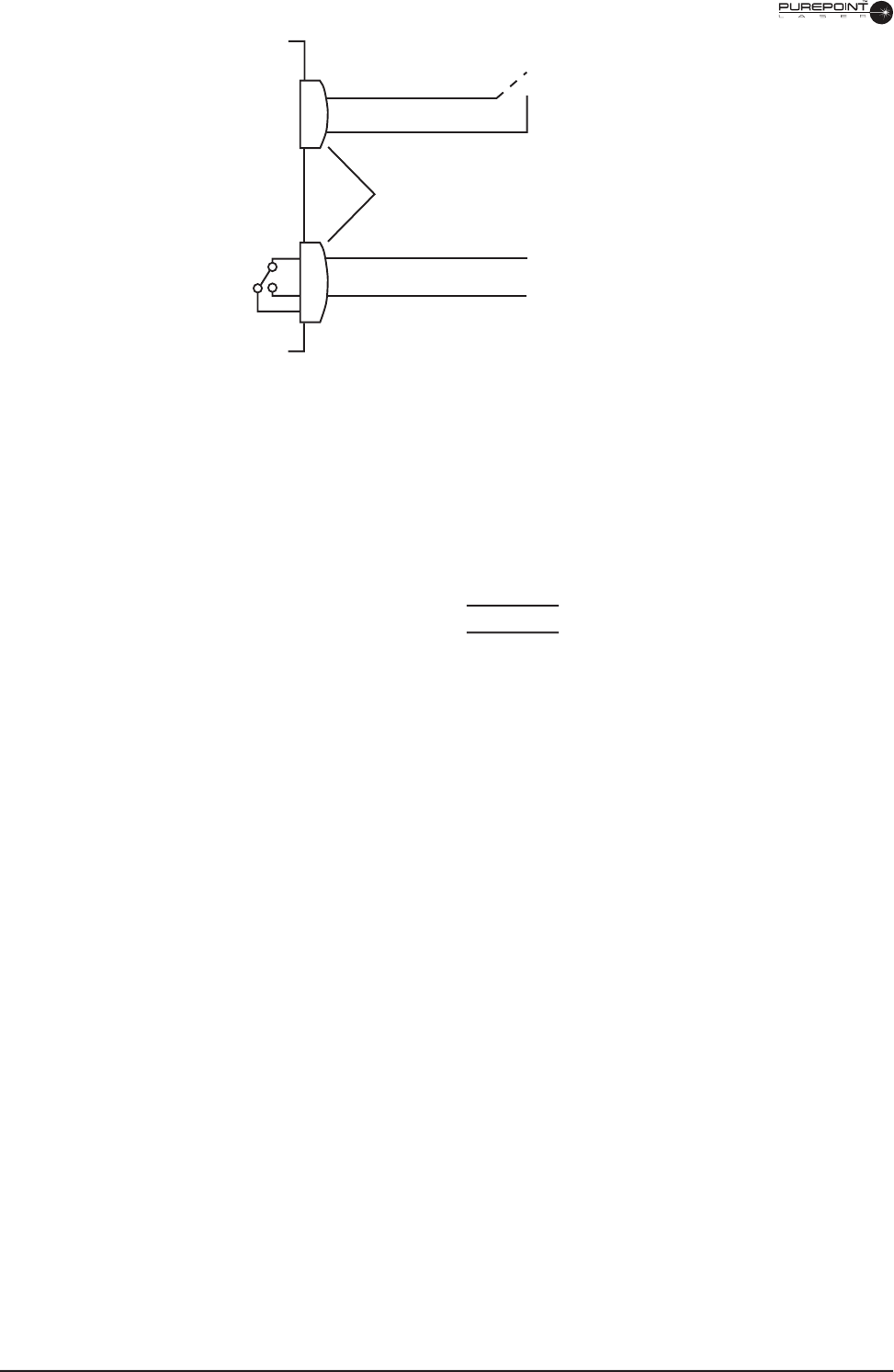
1.12
8065751131
Utility Requirements
Electrical requirement: The
PurePoint™
Laser has a power supply that operates at
100-120 V and 220-240 V input ranges at 50/60 Hz. A properly grounded, standard
plug is the only requirement.
Electrical Connections
CAUTION
Before turning the instrument ON for the fi rst time after receipt of the system, wait one
hour for the components and optics to normalize to avoid possible condensation that
may have occurred during shipping.
Use only <HAR> power cord with a minimum of 10 Amp rating.
Before connecting the main plug verify that:
• The Main Switch on the back panel is in the OFF (O) position.
• The key is in the off (vertical) position, or has been removed.
• The Remote Plug or the interlock cable is connected on the rear panel.
Optical Connections
Optical connections vary in relation to the procedure to be performed. Different
peripherals can be connected to the output ports. These peripherals are:
• Slit Lamp adaptation
• Laser Indirect Ophthalmoscope (LIO)
• Endoprobe/Aspirating Endoprobe/Illuminated Endoprobe
The procedures for connecting these peripherals are contained in Section Three:
Operating Instructions.
Figure 1-5 Remote Connector/Door Lamp Circuit Diagram
REMOTE
CONNECT
9-PIN D-CONNECTOR
CUSTOMER SUPPLIED
DOOR SWITCH (OPTIONAL)
TO DRIVE DOOR LAMP (OPTIONAL)
1
9
3
NONC
COM
1
6

8065751131 1.13
PUREPOINT™
LASER SAFETY FEATURES
The
PurePoint™
Laser is designed for the highest degree of reliability and maximum
safety for both the operator and the patient. Any misuse of this laser system may
be dangerous. Before using the laser system, the operator must be familiar with the
commands and the manipulation of this type of instrument.
The
PurePoint™
Laser is fi tted with the following safety systems which must be
understood by every operator:
• A protective housing covers the laser source so that no harmful laser radiation will
be emitted. No part of this protective housing should be removed by the operator.
The laser system must not be used if the protective housing has been damaged or
removed.
• A remote connection (interlock) is located on the rear panel and permits
the installation of an external switch. Refer to Figure 1-4 for remote switch
connections. This switch can be installed on the laser room door and cuts off all
laser emissions in case the door is opened during operation. There is also a relay
connector for connection to an internal relay to activate a door warning lamp if
desired.
• A key switch controls the laser power supply. Laser operation is not possible if
the key has been removed. Access to the key should be limited to authorized and
knowledgeable personnel. The key should not be left on or near the instrument
when not in use.
• During operation, laser status can be determined by visually checking the LCD
display. The background colors change to indicate the laser’s status for Standby or
Ready modes.
• A green background display indicates that the system is in Ready mode. In
addition, the system will emit a tone to indicate the mode change. The power and
time settings can be set or changed, but not while the laser is being fi red.
• A gray background on the LCD indicates that the system is in Standby mode and
the laser’s default parameters can be altered.
• Under normal Standby, non-fi ring situations, the background display will be grey.
• An emergency switch is mounted on the front panel. Pushing this switch will cut
off all laser emissions (treatment and aiming beam) at any time. The switch must
be pulled out to the initial position to restore power. The laser will always restart
in Standby mode.
• Laser fi ring commands are microprocessor controlled and fi rings are prevented
should any malfunction be detected in the instrument electronics. The instrument
will only fi re when all conditions are correct.
• Output power of the laser beam is continuously monitored and controlled. In
case an unusual power condition is detected, fi ring stops and the treatment laser
emission is cut off.

1.14
8065751131
PROFESSIONAL OPERATOR’S INFORMATION
The following information is given to provide the operator with specifi c information
regarding the
PurePoint™
Laser ophthalmic laser.
Indications
The
PurePoint™
Laser is indicated for use in photocoagulation of both anterior and
posterior segments of the eye including:
Retinal Photocoagulation, panretinal photocoagulation and intravitreal
endophotocoagulation of vascular and structural abnormalities of the retina and
choroid including:
- Proliferative and nonproliferative retinopathy (including diabetic)
- AMD; Wet or Dry to include Macular degeneration
- Retinal tears and detachments
- Macular Edema
- Macular photocoagulation; including grid, focal, Laser Drusen scatter
(panretinal)
- Transcleral Cyclophotocoagulation
- Retinopathy of prematurity;
- Choroidal neovascularization;
- Leaking microaneurysms.
Iridotomy, Iridectomy & Trabeculoplasty for treatment of Chronic/Primary Open
Angle Glaucoma (COAG,POAG), Acute Angle Closure Glaucoma (AACG), and
Refractory Glaucoma.
And other laser treatments including:
- Internal sclerostomy
- Lattice degeneration
- Intra-Ocular Tumors; to include Choroidal Hemangioma, Choroidal
Melanoma, Retinoblastoma; Central and Branch Retinal Vein Occlusion
- Suturelysis
- Vascular and pigmented skin lesions.
- Otosclerotic Hearing Loss
•
•
•
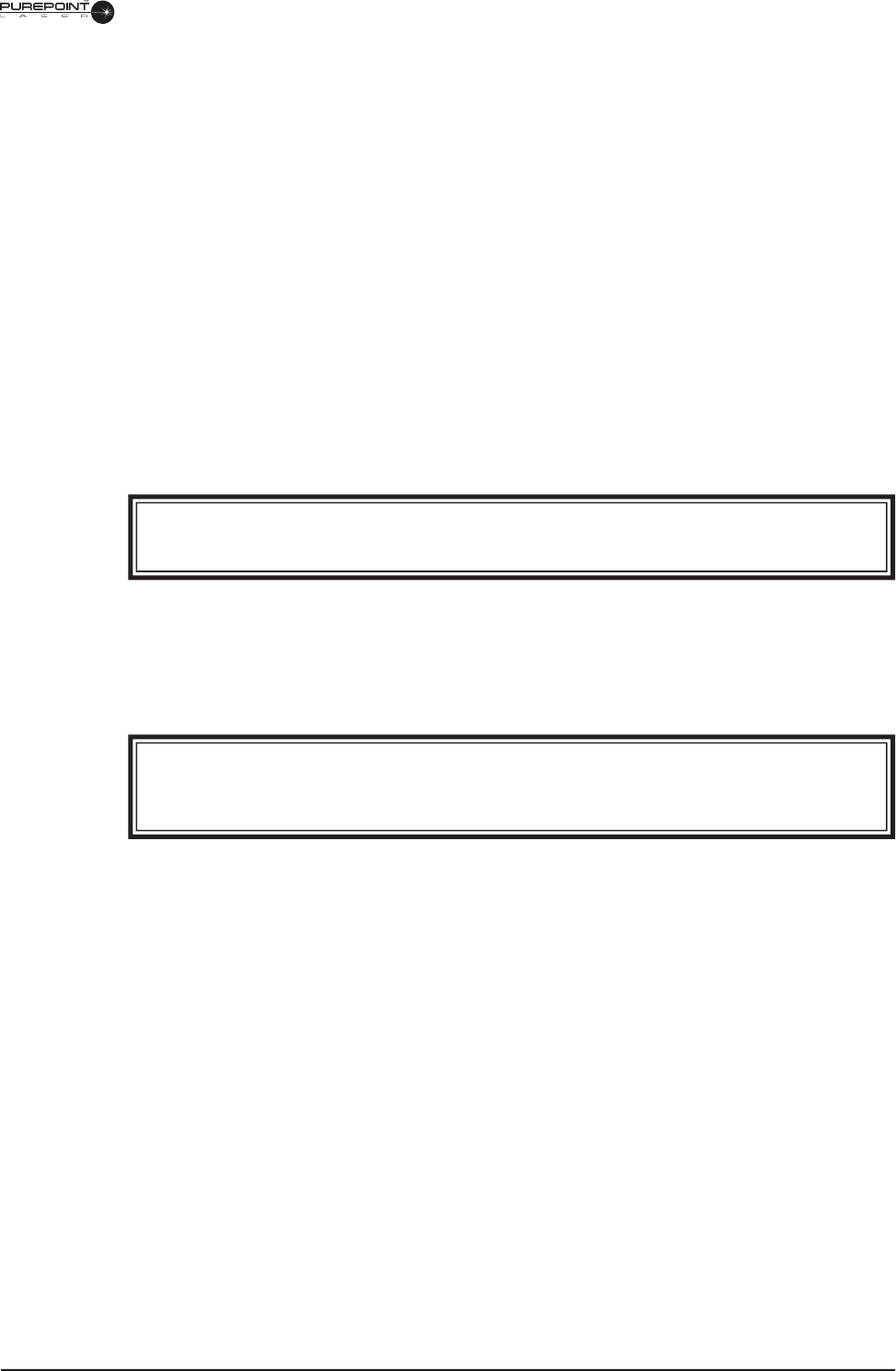
8065751131 1.15
Effects
The laser beam is primarily absorbed by pigmented tissues within the eye. These
primary pigments are hemoglobin/oxy-hemoglobin and melanin. In the case of
macular treatment, xanthophyll pigment is involved. The surgeon controls the power,
spot size, and exposure time of the delivered laser beam to the targeted tissue. It is
the combination of these effects that results in the thermal action of the laser beam
upon tissue. One or all of the adjustable parameters can be changed. However, in
normal clinical practice, power is usually varied, and spot size and exposure time are
preset as a function of the application.
The 532 nm green laser beam has similar absorption characteristics to the 577 nm dye
yellow laser beam
7
. This means that the absorption effects of the 532 nm wavelength
are considerably higher in hemoglobin and melanin, and less in xanthophyll. In
all cases, it is necessary to perform titrations until the desired treatment results are
obtained. The 532 wavelength also requires less power than that required with the
argon laser to obtain similar results. Therefore, you should begin your titration levels
with lower power than required for similar procedures with the argon laser.
WARNING!
Failure to titrate delivered energy may result in patient injury.
Use of this medical laser, as with any other instrument, requires training and
experience to obtain maximum clinical performance. Titrating the dosage is
recommended by initiating a lesion formation in an area of normal retina with intact
pigment epithelium. Power and exposure duration should be varied incrementally
until the desired lesion is produced.
WARNING!
If unsure which settings are required, select low power, short duration, and large
spot size. Failure to do so may result in patient injury.

1.16
8065751131
Delivery of Laser Energy
The laser beam is delivered to tissue via a Slit Lamp, Endoprobe, Illuminated
Endoprobe, aspirating Endoprobe or Laser Indirect Ophthalmoscope (LIO). When
using a Slit Lamp, the laser beam is often used in combination with various contact
lenses to aid in treatment of particular targets such as the fundus. These contact lenses
enable the laser beam to be directed to different sections of the eye.
WARNING!
Some contact lenses, generally classified as wide field or pan fundus lenses, magnify
the laser spot incident upon them. For example, a pan retinal photocoagulation
procedure is normally done with a spot size setting of 500 microns when using
a three mirror lens. If a wide field lens were used, and the laser spot size setting
remained at 500 microns, the actual spot in the eye would be larger than the
indicated spot size setting. Normal increases in spot size in the eye range between
1.3 and 2 times the spot size as selected at the Slit Lamp zoom. These effects
and resultant changes in power density must be considered when using wide
field lenses.
Reaction to applied laser energy by the eye is a function of many variables. The
pigmentation of the eye, technique or procedure used, laser settings, and pre-existing
condition of the eye, such as cataract, will have an effect on the selected laser
parameters and the results obtained. Therefore, it is very important to consider all the
existing clinical conditions and titrate until the desired results are obtained.
Always use minimal illumination from the Slit Lamp while maintaining good
visualization in order to reduce refl ections and discomfort for the patient. Likewise,
the aiming beam should be used at a minimum setting while maintaining proper
targeting of the selected tissue. This will also minimize excessive refl ections and
scattering, particularly at smaller spot sizes.
Doctor Protection Filter
The
PurePoint™
Laser system can only be fi red when appropriate steps are taken to
ensure that a doctor’s fi lter is placed in the viewing device ( e.g. slit lamp, surgical
microscope, etc.). The
PurePoint™
Laser supports three types of doctor fi lters:
• Non-tethered with fi xed fi lter in viewing path.
• Tethered with fi xed fi lter in viewing path.
• Tethered with manual switch to place fi lters in and out of the viewing path.
The Doctor Protection Filter must remain in the beam path during treatment, enabling
the targeted tissue to be seen with complete protection for the operator. The fi lter has
virtually no effect on visualization (colored** view only).
Rotation of the tethered fi lter with manual switch in or out of the beam path is
accomplished by means of a lever located on the right side of the fi lter. Note that if
the Doctor Protection Filter is in the open position in the Slit Lamp or Endo modes,
the laser will not fi re and the message “Please Engage Dr. Filter” will appear. Rotate
the fi lter lever clockwise until the Doctor Protection Filter is in the beam path and the
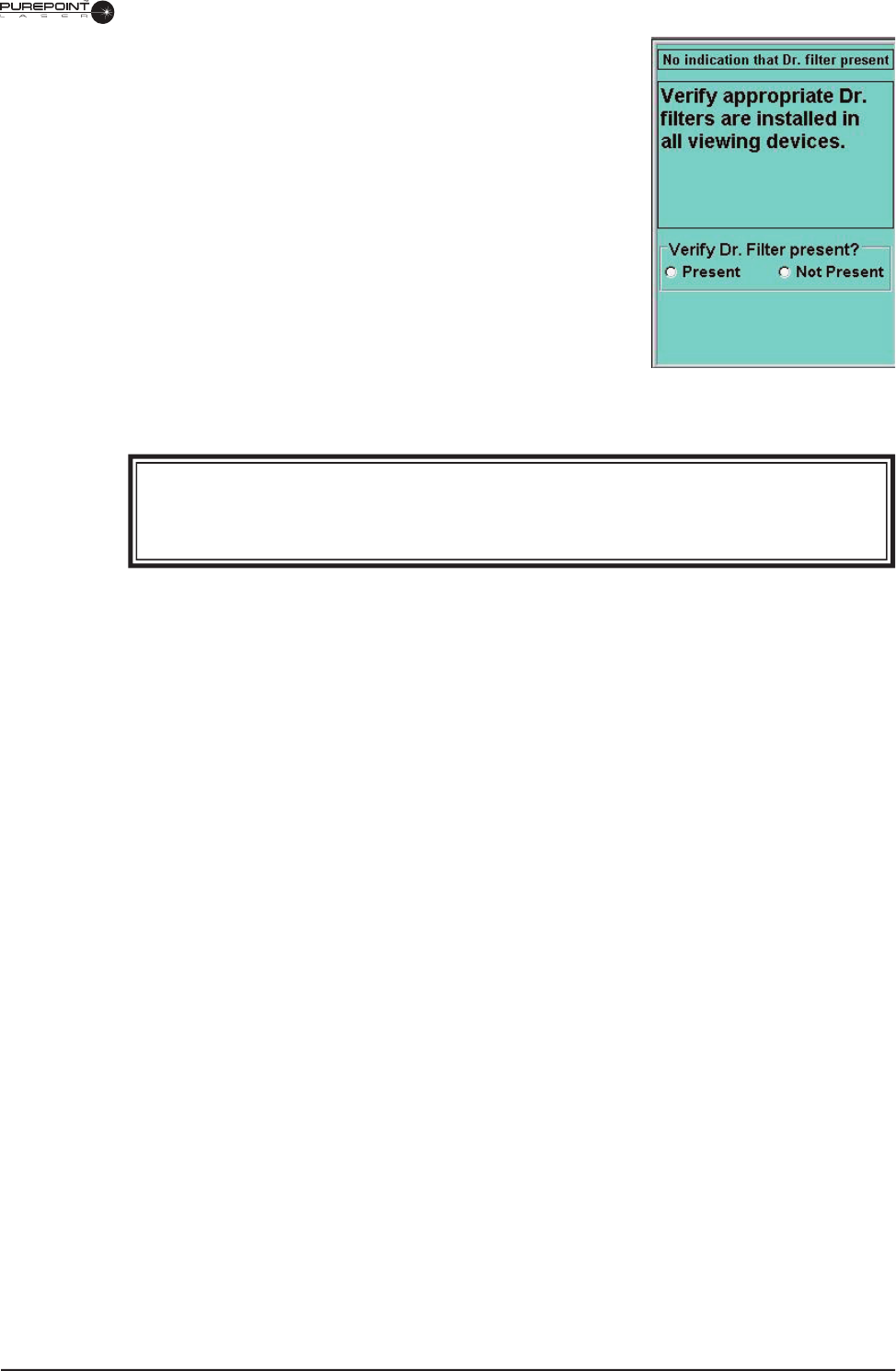
8065751131 1.17
message clears. If using a non-tethered fi xed fi lter, and
the system is switched from Standby to Ready mode,
the message "Verify appropriate Dr. Filters are installed
in all viewing devices" appears and the user must verify
before the laser can switch to Ready mode.
If two tethered fi lters are in place (see rear panel
description), both fi lters must be switched into the beam
path before the laser will operate. Switching either
fi lter out of the beam path while the laser is in Ready
mode switches the laser to Standby mode immediately.
Inserting a fi lter tether into the machine while it is in
Ready mode switches the machine back to Standby
mode until all tethered fi lters have been verifi ed to be in
place.
WARNING!
Do not attempt treatment if aiming beam is not present. Patient injury may
occur.
NOTE: The aiming beam passes down the same delivery system as the working
beam; this provides a good method of checking the integrity of the
delivery system. If the aiming beam spot is not present at the distal end
of the delivery system, if its intensity is reduced, or if it looks diffused
these are possible indications of a damaged or not properly working
delivery system.
Treatment Hazards
A single treatment exposure will typically cause a blanching of target tissue. Exposure
duration can be adjusted from 0.01 seconds to 2.0 seconds to result in the desired
effect. A continuous treatment beam can also be selected.
NOTE: In CW, depending on the thermal load of the system, the system may
shut down in safety mode prior to the footswitch being released.
Excessive combinations of power and exposure can cause undesirable tissue
vaporization and charring. Reports 1-6 (listed as footnotes at the end of this section)
indicate these hazards are no different from adverse effects from continuous wave
argon lasers used at these same settings. No evidence of non-thermal effects has been
observed.
Contra Indications
Patients with a condition that prevents visualization of target tissue (cloudy cornea,
or extreme haze of the aqueous humor of the anterior chamber or vitreous humor) are
poor candidates for Slit Lamp or LIO delivered laser treatment.
Figure 1-6
Dr. Filter Message

1.18
8065751131
Side Effects
Corneal burns, infl ammation, loss of best-corrected visual acuity, loss of visual fi eld,
and transient elevations in intraocular pressure can occur as a result of ophthalmic
laser treatment. Unintentional retinal burns can occur if excessive treatment beam
power or duration is used.
Laser Safety
Back scattered radiation is of low intensity and is not harmful when viewed through
a protective fi lter. All personnel in the treatment room must wear protective eyewear,
OD 4 or above at 532 nm, when the system is in Standby/Ready mode as well as
during treatment. The Doctor Protection Filter is an OD greater than 4 at 532 nm.
WARNING!
Use of controls or adjustments or performance of procedures other than those
specified herein, may result in hazardous laser radiation exposure.
CAUTION
Federal (USA) law restricts this device to sale by, or on the order of, a physician.
1 Ludwig, K.; Lasser, T.; Sakowski, H.; Abramwoski, H.; Worz, G. (Augenklinik,
Universitat Munchen) "Photocoagulation in the edematous and non-edematous
retina with the cw-laser of different wavelengths." Ophthalmologe (GERMANY),
December 1994, Volume 91, No. 6, p783-788.
2 Roider, J.; Schiller, M.; el Hifnawi, E.S.; Birngruber, R. (Augenklinik,
Medizinische Universitat zu Lubeck) "Retinal photocoagulation with a pulsed,
frequency-doubled Nd: YAG laser (532 nm)." Ophthalmologe (GERMANY),
December 1994, Vol. 91 No. 6, p777-782.
3 Wyman, D.; Wilson, B.; Adams, K. (Medical Physics Department, Hamilton
Regional Cancer Centre, Ontario, Canada) "Dependence of laser photocoagulation
on interstitial delivery parameters." Lasers Surgical Medical (UNITED
STATES), 1994, Vol. 14 No. 1, p59-64.
4 Obana, A.; Miki, T.; Matsumoto, M.; Ohtsuka, H.; Moriwaki, M.; Kamo, M.;
Mii, T.; Kijima, M. (Department of Ophthalmology, Osaka City University,
Medical School, Japan) "An experimental and clinical study of chorioretinal
photocoagulation using a frequency-doubled Nd: YAG laser." Nippon Ganka
Gakkai Zasshi (JAPAN), September 1993, Vol. 97 No. 9, p1040-1046.
5 Mordon, S.; Beacco, C.; Rotteleur, G.; Brunetaud, J.M. (INSERM - National
Institute of Health and Medical Research - Lille, France) "Relation between skin
surface temperature and minimal blanching during argon, Nd-YAG 532, and CW
dye 585 laser therapy of port-wine stains." Lasers Surg Med (UNITED STATES)
1993, Vol. 13 No. 1, p124-126.
6 Jalkh, A.E.; Pflibsen, K.; Pomerantzeff, O.; Trempe, C.L.; Schepens, C.L. (Eye
Research Institute of Retina Foundation, Boston, MA 02114) "A new solid-
state, frequency-doubled neodymium-YAG photocoagulation system." Arch
Ophthalmol (UNITED STATES) June 1988, Vol. 106 No. 6, p 847-849.
7 Wavelengths, Opthamology, July 1986, Volume 93, Number 7, Page 956.

8065751131 1.19
PRODUCT SERVICE
For product service, please contact Alcon’s Technical Services Department at the
number provided below.
Operators experiencing problems with the system should refer to the Operating
Instructions and Troubleshooting sections of this manual. A problem which persists
should be referred to the Alcon Technical Services Department or your local
authorized service representative.
For optimum performance, it is the user’s responsibility to schedule preventive
maintenance service on the system and its accessories one time each year. Alcon’s
Field Service Engineers are trained and equipped to provide the highest quality of
workmanship.
Safety performance should be verifi ed by the user (e.g., qualifi ed service personnel) at
least twice a year. Ground resistance must be under 0.1 ohms. Leakage current must
be under 500 µA.
To avoid unnecessary shipping, please contact your Alcon Technical Services
Department prior to return of any system or accessories. If return of the equipment is
deemed necessary, a Return Material Authorization will be issued with appropriate
shipping instructions.
Alcon Laboratories, Inc.
Technical Services Department
15800 Alton Parkway
Irvine, California 926183818
(949) 753-1393
(800) 832-7827

1.20
8065751131
LIMITED WARRANTY
Alcon Laboratories, Inc., will repair or replace at its option, any system or
accompanying accessories (excluding the optical fi ber) found to be defective in
material and/or workmanship for a period of one (1) year from the date of initial
installation. This warranty applies to the original purchaser of the system, when said
system is properly installed, maintained, and operated in accordance with published
instructions.
Alcon Laboratories shall not be obligated to provide services under this warranty for
damage to or destruction of systems covered where such damage or destruction is (i)
a result of or caused by fi re or explosion of any origin, riot, civil commotion, aircraft,
war, or any Act of God including, but not limited to lightning, windstorm, hail,
fl ood, earthquake, or (ii) caused by customer’s misuse or improper servicing of said
systems.
The express warranty above is the sole warranty obligation of Alcon, and the
remedy provided above is in lieu of any and all other remedies. There are no other
agreements, guarantees, or warranties, oral or written, express or implied, including
without limitation warranty of merchantability or fi tness for a particular purpose.
Alcon shall have no liability whatsoever for any incidental or consequential damages
arising out of any defect, improper use, or unauthorized service or repair.
WARNING!
The disposables used in conjunction with Alcon instrument products constitute
a complete surgical system. Use of disposables and handpieces other than those
manufactured by Alcon may affect system performance and create potential
hazards. If it is determined that disposables or handpieces not manufactured
by Alcon have contributed to the malfunction of the equipment during warranty
period, service will be provided at prevailing hourly rates.
LAST PAGE OF THIS SECTION
8065751131LAST PAGE OF THIS SECTION 8065751131